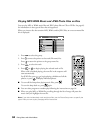32 Using MovieMate With Other Equipment
Considering Color and Surface Quality
For home theater settings, screens come in white or a shade of gray. Gray screens (sometimes
called high contrast screens) increase the natural contrast of images projected in rooms with
ambient light by absorbing the room light and preserving the darker blacks. If you have a
dedicated home theater room with dark walls, ceiling, floor, and furniture, a gray screen may
not provide better contrast than a white screen. However, if you usually project images in a
typical living room or family room with some reflected light, a gray screen will provide better
contrast and a truer viewing experience.
Screen surface quality can also affect the reflectivity of light in your projected image. Screen
reflective properties are measured as “gain” rates, with 1.0 gain as the reflectivity of a white
board. Highly reflective screen surfaces (above 1.0 gain) create a brighter image, but the
brightness may not be uniform enough for a dedicated home theater environment and the
colors may appear to shift from different viewing angles. In a home theater room with
darkened surroundings and controlled lighting, a screen surface with less than 1.0 gain is best.
For rooms where you cannot control the light or will always have ambient light, you may
want to select a screen surface with more than 1.0 gain to compensate for the additional
brightness.


















